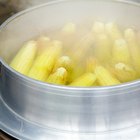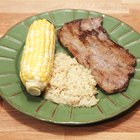
Ablestock.com/AbleStock.com/Getty Images
Frozen corn lasts for six to eight months in the freezer, but the ears of corn must be blanched and dried to keep them from becoming mushy when cooked. Blanching before freezing stops the enzymatic action that can destroy the nutrients and flavor of your corn. Freeze your corn as soon as possible after harvesting to prevent the natural sugars from turning into starch, a major contributor to flavor loss in corn.
Harvest your corn early in the morning for the best flavor and texture. Peel the corn husk back and push your fingernail into a corn kernel; the kernel should produce a milky liquid. This step isn't applicable if you purchase your corn from a produce stand or farmer's market.
Peel the husks from the ears of corn, removing as much of the silk as possible. Scrub the ears of corn lightly with a vegetable brush to remove any remaining silk threads.
Wash any dirt and debris from the ears of corn under cold running water. Place the ears of corn on a cutting board. Trim the remaining stalk stubs from the bottoms of the ears with a kitchen knife.
Fill a large pot about three-quarters full with water. Place the pot onto the stove top over high heat. Allow the water to come to a rolling boil.
Fill an additional large pot or your clean kitchen sink with ice water. Use about 12 cubes of ice per ear of corn.
Lower four or five ears of corn into the boiling water with tongs. Allow the water to return to a full rolling boil. Cover with a tight-fitting lid.
Blanch the ears of corn in boiling water; the National Center for Home Preservation advises blanching for approximately 7 minutes for ears that are up to 1-1/4 inches in diameter, between 7 and 9 minutes for ears that are between 1-1/4 and 1-1/2 inches in diameter and 9 to 11 minutes for ears larger than 1-1/2 inches in diameter. Pull the ears of corn from the boiling water with tongs after the proper blanching time has been met.
Plunge the hot ears of corn directly into the ice water immediately after blanching. Allow the ears of corn to cool for the same amount of time used to blanch them.
Dry each ear of corn completely with paper towels before freezing. This reduces the amount of ice crystal formation on the corn while freezing, which helps prevent the corn from becoming mushy.
Wrap each individual ear of corn in plastic wrap. If steam develops inside the plastic wrap, the corn is not completely cooled and must be unwrapped and cooled completely before rewrapping and freezing; any steam trapped inside the plastic wrap will cause ice crystal formation, which will lead to mushy corn.
Slide the individually wrapped ears of corn into plastic freezer storage bags or containers. Remove as much air as possible from the packages before sealing. The individual plastic wrapping and freezer containers provide extra moisture-vapor protection to keep the corn as fresh as possible.
Label the bags or containers with the date of storage and place them in the freezer.
Related Articles

How to Freeze Sweet Corn Off the Cob

How to Freeze Fresh Corn on the Cob

How to Steam Frozen Corn on the Cob

How to Roast Frozen Corn With Olive Oil
How to Freeze Corn on the Cob Without ...

How to Cook Oven-Roasted Corn

How to Use Foodsaver for Freezing Corn

How to Microwave Corn on the Cob With ...

How to Roast Corn in the Husk

Different Ways to Cook Whole Kernel Corn

How Long Do Ears of Corn Take to Roast ...

How to Dry Corn on the Cob

How to Dry Corn for Popcorn

How to Roast Corn in a Pan

How to Cook Corn on the Cob in the ...

How to Can Pickled Corn in Jars

Different Ways to Cook Canned Corn

How to Freeze Romanesco

Why Is My Boiled Corn Chewy?

How to Dry Corn on the Cob for Feeding ...
References
- The Ohio State University Extension: Freezing Vegetables
- University of Wisconsin-Madison Extension: Delicious Frozen Corn Year Round
- University of Georgia National Center for Home Food Preservation: Corn; On or Off the Cob
- University of Minnesota Extension: Food Safety; Vegetables and Herbs: Freezing Sweet Corn
Tips
- Store corn in the refrigerator within a few hours of harvesting to keep them fresh until they can be frozen.
- Eat the frozen corn within eight months of the storage date.
Writer Bio
A former cake decorator and competitive horticulturist, Amelia Allonsy is most at home in the kitchen or with her hands in the dirt. She received her Bachelor's degree from West Virginia University. Her work has been published in the San Francisco Chronicle and on other websites.
Photo Credits
Ablestock.com/AbleStock.com/Getty Images